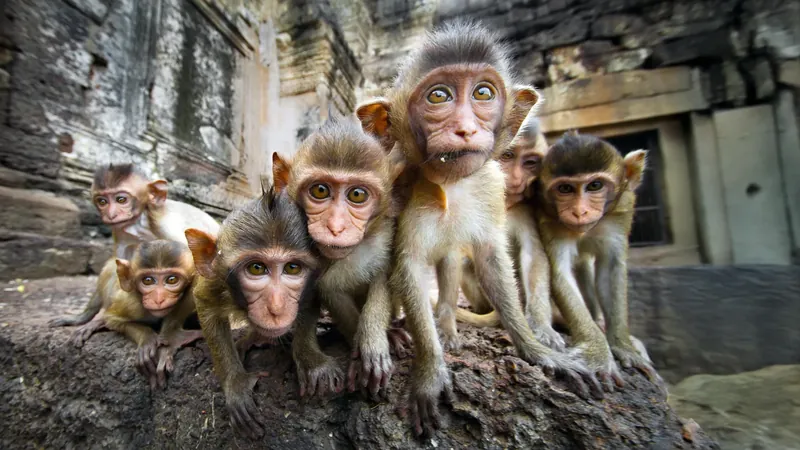
Why Monkeys and Humans Can't Resist a Good Conflict
2025-07-10
Author: Rajesh
The Intriguing Connection Between Monkeys and Humans
A groundbreaking new study reveals that long-tailed macaques have a surprising fondness for the same type of content that captivates humans: videos showcasing social conflicts and familiar faces. What could this mean for our understanding of social behavior?
Brad Bushman, co-author of the study and a communication professor at The Ohio State University, notes, "Both humans and macaques are social creatures driven by a fundamental need to belong. It's no wonder they gravitate towards content that may help them navigate their social networks."
The Study: Watching Conflict Unfold
Published recently in 'Animal Cognition', the research led by Elisabeth H.M. Sterck from Utrecht University involved 28 macaques at a primate research center in the Netherlands. Equipped with a series of two-minute videos, each featuring monkeys in varying activities—conflict, grooming, running, or sitting—the study aimed to observe what piqued the macaques' interest.
The results were enlightening: macaques spent the most time glued to videos displaying confrontations, followed by videos of running monkeys. Grooming and sitting scenes? Not so much.
Evolutionary Insights into Our Behavior
Bushman points out the evolutionary implications: "This attraction to aggressive media isn't just a human trait—other primates appear to be wired for it as well. Paying attention to aggression could be a survival mechanism, enhancing their chances of navigating social landscapes effectively."
Another fascinating discovery? Macaques paid greater attention to familiar group members over strangers. Sterck elaborated, "Gathering social information within their own group outweighs the need to learn about outsiders."
Familiar Faces and the Power of Recognition
This preference for the known resonates with humans too. Bushman quips, "When watching films, we gravitate towards familiar actors and big-name stars rather than unfamiliar faces. It seems monkeys share this trait!"
Rank and Behavior: Who's Watching What?
Interestingly, lower-ranking and less aggressive macaques showed heightened attention to the videos. Sterck explains, "Dominant monkeys, confident in their status, may feel less compelled to monitor aggression. In contrast, those lower in rank are at greater risk of becoming victims, thus they watch more closely."
Moreover, macaques that exhibited higher stress levels were less focused on group members in the videos, suggesting that personality and behavioral tendencies significantly influence their viewing habits.
Experimental Setup: A Unique Viewing Experience
The study was conducted with macaques housed in separate enclosures at the Biomedical Primate Research Centre. Videos of unfamiliar monkeys were shown, ensuring the subjects were isolated during the two-minute viewing periods. The monkeys participated voluntarily while situated in a designated corridor.
According to Sterck, "Macaques are highly visual animals with keen eyesight, similar to that of humans, making them particularly receptive to watching videos."
Bridging the Gap Between Species
The findings underscore a remarkable link between humans and our primate relatives: an irresistible attraction to conflict. Bushman concludes, "Even brief exposure to aggression in media captured these macaques' attention, revealing essential insights into why humans are so drawn to violent content."
With such parallels, it's evident that our fascination with social conflicts has deep evolutionary roots shared across species.
Meet the Team Behind the Study
The research featured contributions from several co-authors from Utrecht University, including Sophie Kamp, Ive Rouart, Lisette van den Berg, Dian Zijlmans, and Tom Roth.



 Brasil (PT)
Brasil (PT)
 Canada (EN)
Canada (EN)
 Chile (ES)
Chile (ES)
 Česko (CS)
Česko (CS)
 대한민국 (KO)
대한민국 (KO)
 España (ES)
España (ES)
 France (FR)
France (FR)
 Hong Kong (EN)
Hong Kong (EN)
 Italia (IT)
Italia (IT)
 日本 (JA)
日本 (JA)
 Magyarország (HU)
Magyarország (HU)
 Norge (NO)
Norge (NO)
 Polska (PL)
Polska (PL)
 Schweiz (DE)
Schweiz (DE)
 Singapore (EN)
Singapore (EN)
 Sverige (SV)
Sverige (SV)
 Suomi (FI)
Suomi (FI)
 Türkiye (TR)
Türkiye (TR)
 الإمارات العربية المتحدة (AR)
الإمارات العربية المتحدة (AR)